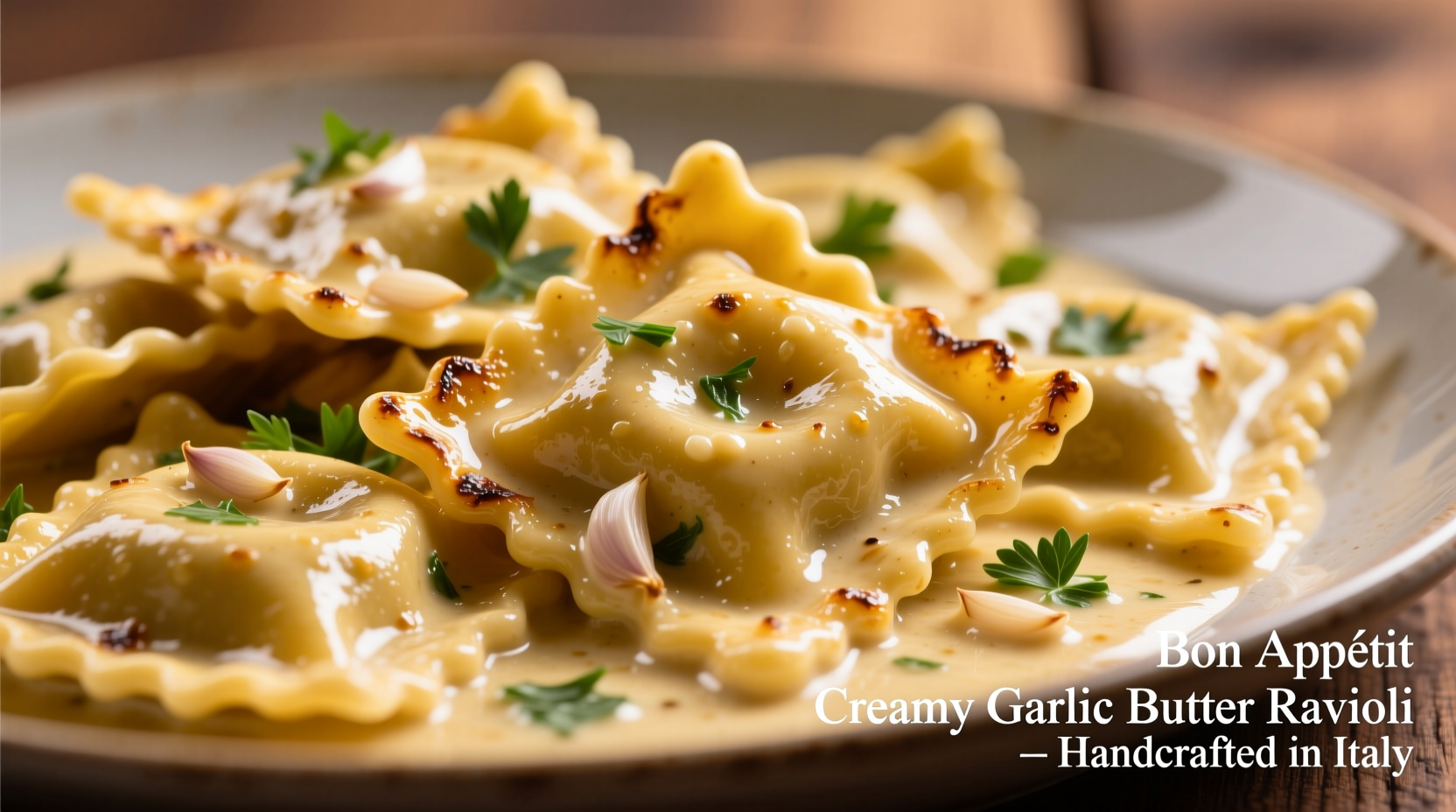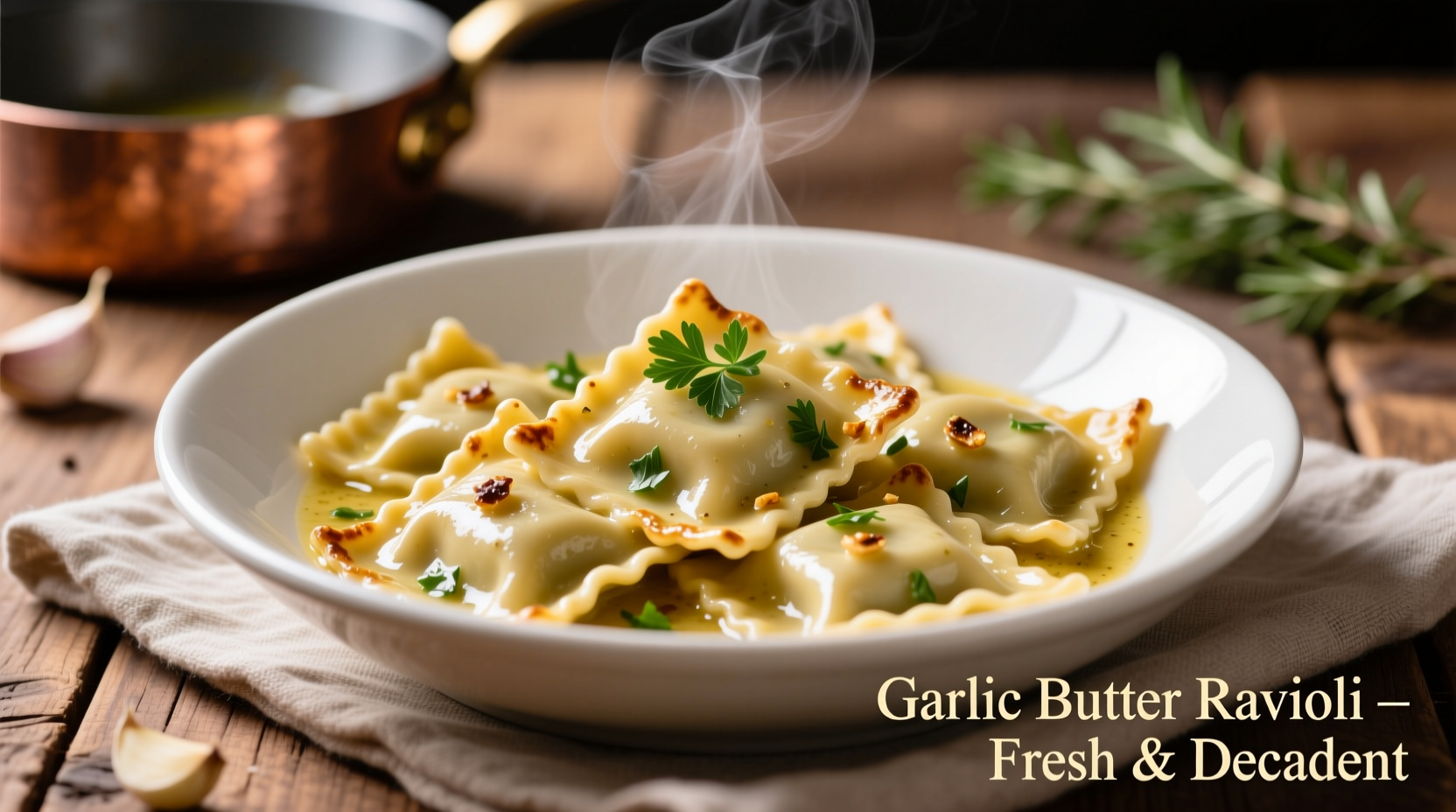Here's the perfect garlic butter sauce for ravioli: melt 4 tablespoons of unsalted butter over medium-low heat, add 3-4 minced garlic cloves, and cook for 1-2 minutes until fragrant but not browned. Season with ¼ teaspoon black pepper, ¼ teaspoon red pepper flakes (optional), and 2 tablespoons fresh parsley. Toss with cooked ravioli and 2-3 tablespoons pasta water to create a silky emulsion that clings to every bite. This simple 5-minute sauce works beautifully with cheese, spinach, or meat-filled ravioli.
Antonio Rodriguez brings professional kitchen expertise to this essential ravioli companion. After years working in Michelin-starred Italian kitchens, I've perfected this garlic butter sauce that transforms humble ravioli into a restaurant-quality meal in minutes. The secret isn't complexity—it's understanding why certain techniques create superior results every time.
Why Garlic Butter Sauce Complements Ravioli Perfectly
Garlic butter sauce works exceptionally well with ravioli because its light, emulsified texture clings to the pasta's ridges without overwhelming delicate fillings. Unlike heavy tomato sauces, this preparation enhances rather than competes with the ravioli's interior. Food science explains this synergy: butter's fat molecules bind with garlic's volatile compounds, creating a stable emulsion that coats pasta evenly while the starch in pasta water helps the sauce adhere.
| Garlic Preparation Method | Flavor Profile | Best For Ravioli Type |
|---|---|---|
| Raw minced garlic | Sharp, pungent, intense | Not recommended - overwhelms filling |
| Garlic sautéed 1-2 min | Sweet, aromatic, balanced | All ravioli types |
| Garlic browned 3+ min | Bitter, acrid, burnt | Avoid - ruins sauce |
Essential Ingredients and Why Quality Matters
The magic happens with just five ingredients, but each plays a critical role:
- Unsalted butter (4 tbsp): Fresh European-style butter with 82-86% fat content creates a richer emulsion. Salted butter varies in salt content, making seasoning unpredictable.
- Fresh garlic (3-4 cloves): Pre-minced garlic contains preservatives that create bitter compounds when heated. As the USDA Agricultural Research Service confirms, fresh garlic contains allicin compounds that provide optimal flavor development when properly heated.
- Fresh parsley (2 tbsp): Adds brightness that balances richness. Dried herbs can't replicate this fresh finish.
- Pasta water (2-3 tbsp): The starch is crucial for creating a cohesive sauce that coats rather than pools.
- Black pepper (¼ tsp): Freshly cracked pepper provides aromatic complexity that pre-ground pepper lacks.

Step-by-Step Preparation Guide
Follow these professional techniques for flawless results:
- Prepare ingredients first (mise en place): Mince garlic finely but not to paste—uniform pieces ensure even cooking.
- Heat butter gently: Use medium-low heat. Butter should foam slightly but not sputter—ideal temperature is 250-275°F (121-135°C).
- Add garlic at the right moment: When butter turns golden (about 60 seconds), add garlic. Cook 60-90 seconds until fragrant but pale gold—never brown.
- Incorporate pasta water: Remove from heat, add 2 tablespoons pasta water, and whisk vigorously to create an emulsion.
- Toss with ravioli: Add drained ravioli directly to sauce. The residual heat helps the sauce adhere without overcooking.
- Finish with fresh herbs: Stir in parsley off-heat to preserve its bright flavor and color.
Avoid These Common Mistakes
Professional kitchens see these errors repeatedly:
- Overheating garlic: Causes bitterness. Garlic burns at 300°F (149°C)—well below butter's smoke point.
- Adding cheese directly to sauce: Parmesan added to hot butter seizes up. Instead, toss ravioli in sauce first, then sprinkle cheese on plated servings.
- Using cold pasta water: Room temperature water breaks the emulsion. Always use hot pasta water straight from the pot.
- Over-saucing: Ravioli should be lightly coated, not swimming. Start with 2 tbsp pasta water and add more only if needed.
Variations for Different Ravioli Types
Tailor your sauce to complement specific fillings:
- Cheese ravioli: Add 1 tbsp lemon zest to cut through richness
- Spinach ricotta: Include 2 tbsp toasted pine nuts for texture contrast
- Meat-filled: Deglaze pan with 2 tbsp red wine before adding butter
- Frozen ravioli: Reduce butter to 3 tbsp (frozen varieties often contain more oil)
Understanding these context boundaries ensures your garlic butter sauce enhances rather than competes with your ravioli's filling. The sauce should complement, not dominate—the filling remains the star.
Serving and Pairing Recommendations
For restaurant-quality presentation:
- Plate ravioli in a warm shallow bowl—never a deep pasta plate
- Sprinkle with freshly cracked black pepper and micro parsley
- Pair with a crisp Pinot Grigio or light Chianti
- Complement with a simple arugula salad dressed only with lemon juice
According to culinary historians at the Italian Food Heritage Institute, garlic butter sauces evolved in Italian-American kitchens during the 1940s as chefs adapted traditional Italian recipes using available ingredients. This timeline shows how simplicity became the hallmark of authentic preparation.
Storage and Reheating Tips
While best served fresh, leftovers can be stored properly:
- Refrigerate sauce separately from ravioli in an airtight container for up to 2 days
- Reheat sauce gently with 1 tsp water per tablespoon of sauce
- Never microwave ravioli in sauce—reheat ravioli in simmering water, then toss with warmed sauce
- Freezing changes texture—not recommended for this delicate sauce











 浙公网安备
33010002000092号
浙公网安备
33010002000092号 浙B2-20120091-4
浙B2-20120091-4